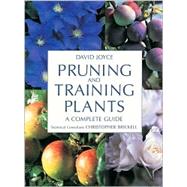
David Joyce is a writer and plant advisor with a passionate interest in plants and the history of their cultivation. His other books include The English Garden Tradition, Garden Styles, Hanging Baskets, Window Boxes and Containers and Windowbox Gardening.
| Foreword | |
| Introduction | |
| Ornamentals | |
| Roses | |
| Modern Bush Roses | |
| Species and Shrub Roses | |
| Climbers and Ramblers | |
| Standard Roses | |
| Exhibition Roses | |
| Rose Hedges/Renovation | |
| A-Z Of Roses Trees | |
| Feathered Trees | |
| Standard Trees | |
| The Care of Established Trees | |
| Shrubs | |
| Deciduous Shrubs | |
| Evergreen Shrubs | |
| Renovation | |
| Climbers and Wall Shrubs | |
| Hedera | |
| Clematis | |
| Wisterias | |
| Ceanothus | |
| Chaenomeles and Pyracantha | |
| Hedges | |
| Formal Hedges | |
| Pleaching | |
| Arbours and Tunnels | |
| Renovating Formal Hedgs | |
| Informal and Rustic Hedges | |
| Topiary | |
| Geometric Shapes | |
| Representational Shapes | |
| A-Z of Ornamentals Pinch Pruning | |
| Cascase Chrysanthemums | |
| Fuchsias | |
| Coleus | |
| Pelargoniums | |
| Miscellaneous Ornamentals Tree Fruits | |
| Apples and Pears | |
| Bushes and Standards | |
| Spindlebush Trees | |
| Cordons | |
| Espaliers | |
| Dwarf Pyramids | |
| Fans, Arches, and Tunnels | |
| Plums | |
| Pyramid Plums | |
| Fan-trained Plums | |
| Sweet and Duke Cherries | |
| Acid Cherries | |
| Peaches | |
| Apricots | |
| Figs | |
| Renovation Of Fruit Trees | |
| Other Fruit Trees | |
| Citrus Fruits | |
| Quinces and Medlars | |
| Mulberries | |
| Elderberries | |
| Cobnuts and Filberts | |
| Walnuts/Pecans/Chestnuts | |
| Olives | |
| Persimmons and PomergranatesSoft Fruits and Vines | |
| Gooseberries | |
| Red And White Currants | |
| Black Currants | |
| Raspberries | |
| Blackberries | |
| Blueberries And Cranberries | |
| Grapes | |
| Passion Fruit | |
| Kiwi Fruit | |
| Tools and Equipment | |
| Glossary | |
| Index | |
| Further Reading | |
| Acknowledgements | |
| Table of Contents provided by Publisher. All Rights Reserved. |
The New copy of this book will include any supplemental materials advertised. Please check the title of the book to determine if it should include any access cards, study guides, lab manuals, CDs, etc.
The Used, Rental and eBook copies of this book are not guaranteed to include any supplemental materials. Typically, only the book itself is included. This is true even if the title states it includes any access cards, study guides, lab manuals, CDs, etc.